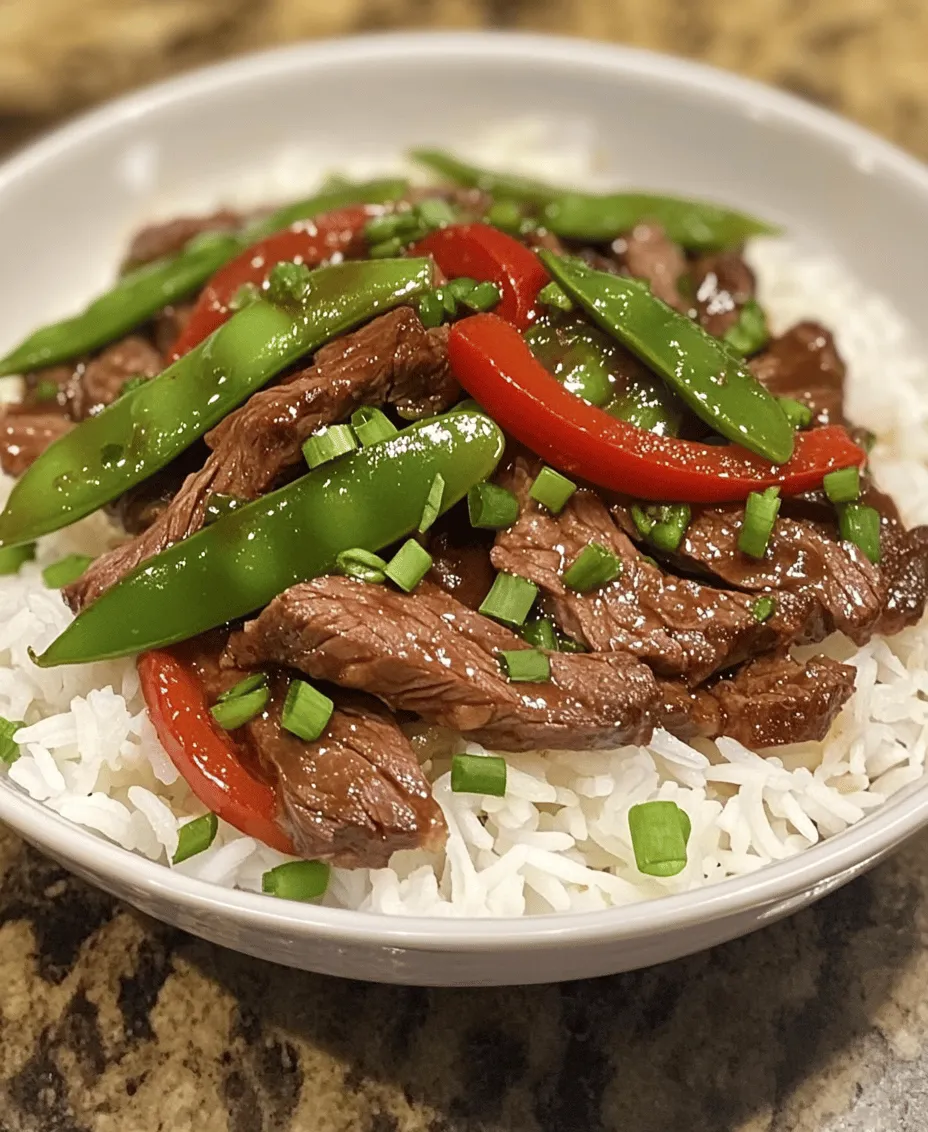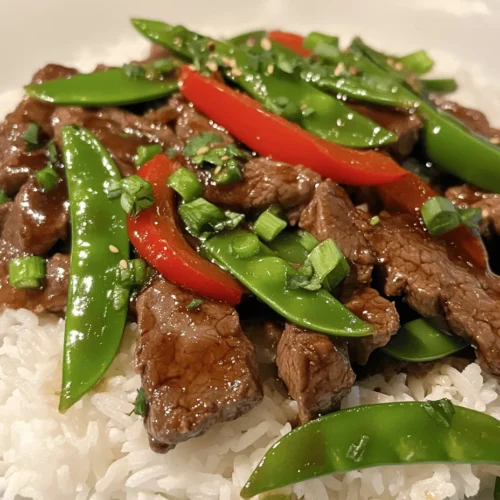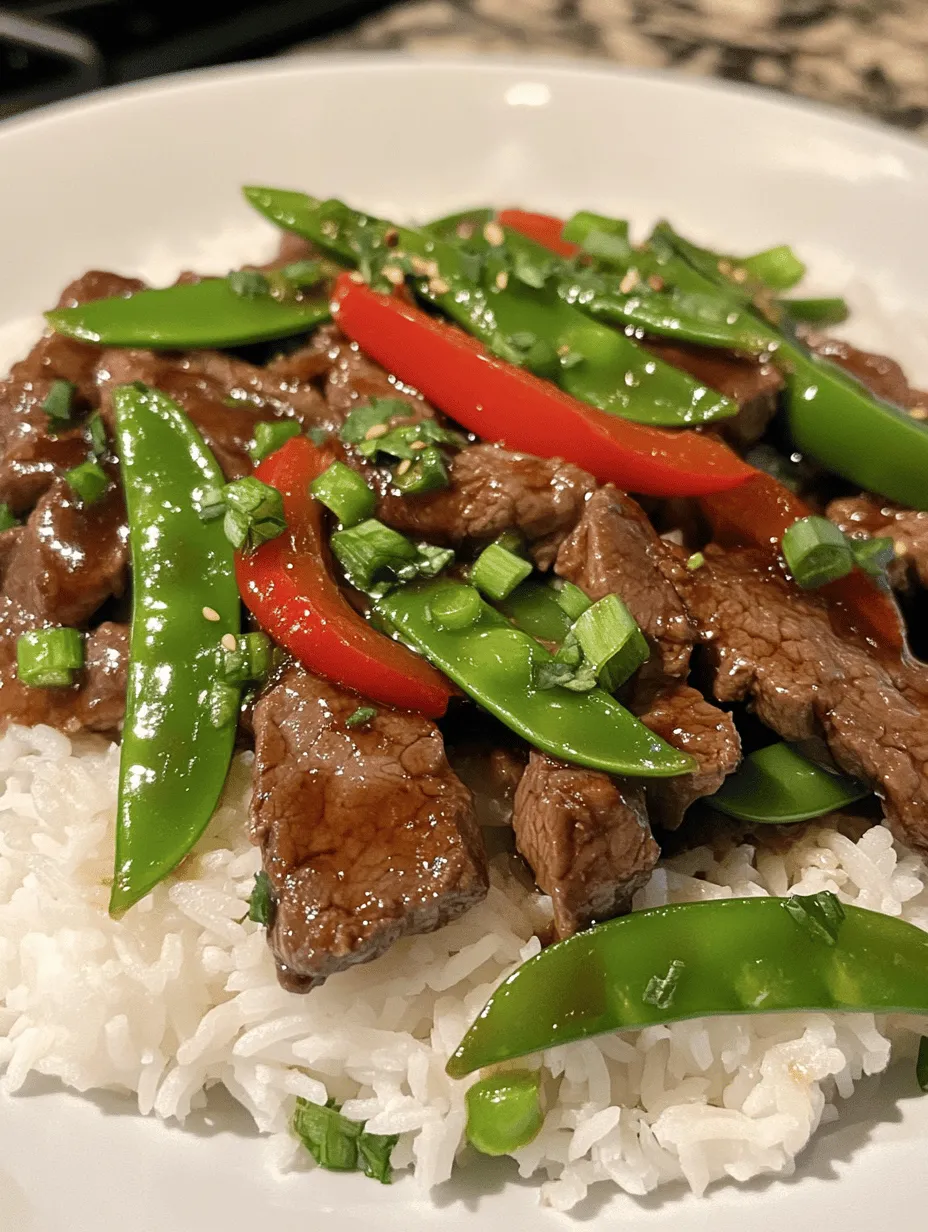Introduction
When it comes to the rich tapestry of Asian cuisine, few dishes encapsulate the balance of flavors quite like Beef with Oyster Sauce. This beloved recipe is not just a staple in many households; it serves as a celebration of culinary artistry that marries savory, sweet, and umami flavors. Across various cultures, particularly in Chinese cooking, the harmony of ingredients is paramount, reflecting a deep respect for the balance of taste and texture. In this dish, the tender beef, vibrant vegetables, and the distinctive oyster sauce work together to create a satisfying meal that is both hearty and nourishing.
Oyster sauce, a key ingredient in this dish, has a fascinating history. Believed to have originated in the late 19th century, it was discovered by accident when a chef in Guangdong simmered oysters in a pot until they transformed into a thick, savory sauce. Fast forward to today, and oyster sauce has become a staple in many kitchens around the world, known for its ability to elevate dishes with its rich, umami flavor. In beef stir-fry, it adds depth and complexity, bringing out the natural flavors of the meat and vegetables.
In this article, we will guide you through the process of making Beef with Oyster Sauce, including insights on ingredient selection, marination techniques, and cooking methods that ensure a delicious outcome. Whether you are an experienced cook or a novice in the kitchen, this recipe is designed to be approachable and rewarding.
Understanding the Ingredients
To create a mouthwatering Beef with Oyster Sauce, understanding the ingredients and their flavor profiles is essential. Each component plays a vital role in crafting a dish that bursts with authentic taste.
Beef Flank Steak: Choosing the Right Cut
The choice of beef is crucial in this recipe. Flank steak is the recommended cut, known for its rich flavor and slightly chewy texture. This cut comes from the abdominal muscles of the cow and is best when cooked quickly at high temperatures. It is essential to slice the flank steak against the grain to ensure tenderness.
When selecting flank steak, look for a piece that is bright red with a good amount of marbling. The marbling refers to the small flecks of fat within the muscle, which contribute to the flavor and juiciness of the meat. Aim for a thickness of about one inch, as this will allow for even cooking.
Oyster Sauce: Origin and Culinary Uses
Oyster sauce is the star ingredient in this dish, providing a unique umami flavor that enhances the overall taste profile. Made from cooking oysters in water and then thickening the resulting liquid with cornstarch, it has a savory and slightly sweet flavor that pairs beautifully with beef.
In addition to stir-fries, oyster sauce can be used in marinades, dipping sauces, and even as a glaze for grilled meats. Its versatility makes it a kitchen essential, particularly in Asian cooking, where it is often used to add depth to sauces and dishes.
Soy Sauce: Importance in Asian Cooking
Soy sauce is another integral component of this recipe, known for its salty and savory profile. It is made from fermented soybeans, and its depth of flavor complements the sweetness of the oyster sauce. Soy sauce not only enhances the taste of the beef but also contributes to the overall color of the dish, giving it a rich, appetizing hue.
There are different types of soy sauce, including light and dark varieties. For this recipe, a good-quality dark soy sauce is recommended, as it adds a deeper flavor and color to the stir-fry.
Cornstarch: The Secret to Tender Meat
Cornstarch plays a pivotal role in achieving tender beef in stir-fry dishes. When combined with soy sauce or oyster sauce and applied to the meat before cooking, it creates a protective coating that locks in moisture and prevents the beef from becoming tough during the cooking process. This technique is often referred to as “velveting” and is a common practice in Chinese cuisine.
Vegetable Oil: Best Options for High-Heat Cooking
When it comes to cooking stir-fries, using the right oil is essential. Vegetable oil is the best choice due to its high smoke point, which allows for quick cooking at high temperatures without burning. Other suitable options include canola oil or peanut oil, both of which can withstand the heat while adding subtle flavor to the dish.
Red Bell Pepper and Snow Peas: Nutritional Values and Taste
To add color and nutrition to the dish, we will incorporate red bell pepper and snow peas. Red bell peppers are not only visually appealing but also packed with vitamins A and C, making them a healthy addition. Their sweet, crisp texture complements the savory flavors of the beef and oyster sauce.
Snow peas, on the other hand, are tender and slightly sweet, providing a delightful crunch to the stir-fry. They are low in calories and high in fiber, making them a nutritious choice for any meal. Including these vegetables enhances the dish’s flavor and texture while contributing to a well-rounded meal.
Garlic and Ginger: Essential Aromatics in Asian Dishes
No Asian stir-fry is complete without the aromatic duo of garlic and ginger. Garlic adds a pungent and savory note, while ginger provides a warm, zesty flavor that brightens the dish. Together, they create a fragrant base that infuses the beef and vegetables with aromatic goodness.
For this recipe, using fresh garlic and ginger is highly recommended. Mince them finely to release their essential oils and ensure they blend seamlessly into the dish.
Sesame Oil: Flavor Enhancer and Its Health Benefits
Sesame oil is another essential ingredient that adds a nutty flavor and aroma to the finished dish. A drizzle of toasted sesame oil at the end of cooking elevates the flavor profile, creating a richer and more complex taste. Additionally, sesame oil contains healthy fats and antioxidants, making it a beneficial addition to your cooking repertoire.
Green Onions: Garnishing and Adding Freshness
Green onions, also known as scallions, are used as a garnish in this recipe. Their mild onion flavor and vibrant green color add freshness and visual appeal to the dish. They can be sliced and sprinkled on top just before serving, providing a delightful crunch and brightness.
Jasmine Rice: Ideal Pairing with Stir-Fry Dishes
To complete the meal, serve Beef with Oyster Sauce over a bed of fluffy jasmine rice. This aromatic rice variety is perfect for soaking up the savory sauce and balancing the flavors of the stir-fry. Jasmine rice has a subtle floral aroma and a slightly sticky texture that complements the dish beautifully.
The Marination Process: Elevating Flavor
Marinating the beef is a crucial step in enhancing its flavor and tenderness. The combination of oyster sauce and soy sauce not only infuses the meat with delicious taste but also helps to tenderize it, making every bite succulent and enjoyable.
Importance of Marinating Beef for Tenderness and Flavor
Marinating beef is an essential technique in achieving a juicy and flavorful stir-fry. The acids in the marinade help to break down the proteins in the meat, resulting in a tender texture. Additionally, marinating allows the flavors to penetrate the beef, ensuring that every bite is packed with savory goodness.
Step-by-Step Guide on Marinating with Oyster Sauce and Soy Sauce
1. Prepare the Marinade: In a bowl, combine 2 tablespoons of oyster sauce, 2 tablespoons of soy sauce, and 1 tablespoon of cornstarch. Mix thoroughly until the cornstarch is fully dissolved.
2. Slice the Beef: Take the flank steak and slice it against the grain into thin strips, about 1/4 inch thick. This will help to maximize tenderness.
3. Marinate the Beef: Add the sliced beef to the marinade, ensuring that each piece is well-coated. Cover the bowl with plastic wrap or transfer the mixture to a resealable plastic bag, removing as much air as possible.
4. Chill: Place the marinated beef in the refrigerator for at least 30 minutes. For optimal flavor, marinate for 1-2 hours or even overnight if you have the time.
Recommended Marination Time for Optimal Results
While a minimum of 30 minutes will provide some flavor, marinating for longer periods will yield the best results. If you can, aim for 1-2 hours to allow the flavors to meld and the beef to become tender. For meal prep enthusiasts, marinating the beef the night before is a great way to save time and enhance flavor for a quick weeknight dinner.
Tips for Marinating in Advance for Meal Prepping
– Batch Marination: Consider marinating a larger batch of beef and freezing it for later use. Just remember to label the bag with the date and contents.
– Use Fresh Ingredients: Always opt for fresh garlic and ginger in the marinade for the best flavor.
– Avoid Over-Marinating: While marinating is beneficial, avoid leaving the beef in the marinade for more than 24 hours, as it may become mushy.
Cooking Techniques for Perfect Stir-Fry
Once your beef is marinated and ready, it’s time to focus on the cooking techniques that will bring this dish to life. Stir-frying is a quick and efficient method that requires high heat and proper equipment.
Choosing the Right Equipment: Skillet vs. Wok
While you can use a heavy skillet for stir-frying, a wok is the traditional and preferred choice for this cooking method. The wok’s unique shape allows for even heat distribution and provides ample surface area for cooking the beef and vegetables quickly. If you don’t have a wok, a large, heavy-bottomed skillet will work just fine.
Importance of High Heat in Stir-Frying
Stir-frying is all about speed and high heat. The goal is to cook the beef and vegetables quickly, retaining their vibrant colors and crisp textures. To achieve this, preheat your wok or skillet until it is very hot before adding the oil. This high heat will also help to sear the beef, locking in juices and enhancing flavor.
With the ingredients prepared and the marination process complete, you are now ready to embark on the cooking journey to create a delicious Beef with Oyster Sauce that will surely impress your family and friends. Stay tuned for the next part, where we will dive into the cooking process and tips for achieving the perfect stir-fry.

Techniques for Searing Meat: Ensuring a Good Brown Crust
Achieving a beautiful brown crust on your beef is crucial for flavor development in your stir-fry. Here are some key techniques to ensure you get that perfect sear:
1. Temperature Matters: Start by heating your pan over medium-high to high heat. A hot pan is essential for creating the Maillard reaction, which gives meat its rich color and flavor. You can test the heat by flicking a drop of water into the pan; if it dances and evaporates quickly, the pan is ready.
2. Pat Dry: Before cooking, pat the beef slices dry with paper towels. Moisture can prevent the meat from achieving a good sear, leading to steaming rather than browning.
3. Use the Right Oil: Choose an oil with a high smoke point, such as vegetable oil or canola oil. This will help you achieve the desired sear without burning the oil.
4. Don’t Overcrowd the Pan: When cooking, avoid adding too much beef at once. Overcrowding lowers the pan’s temperature, resulting in steaming rather than searing. Cook in batches if necessary.
5. Let It Rest: After searing, allow the meat to rest for a few minutes before slicing or serving. This helps retain its juices and enhances the overall flavor.
Managing Cooking Times for Beef and Vegetables to Preserve Texture and Flavor
In a stir-fry, timing is everything. Each ingredient requires specific cooking times to ensure that it retains its texture and flavor. Here’s how to manage them effectively:
– Beef: Depending on the thickness of your beef slices, they will typically require 2 to 4 minutes to cook through. Aim for a medium rare to medium doneness. Overcooking can lead to tough, chewy meat.
– Vegetables: Softer vegetables like bell peppers and mushrooms should be added after the beef has seared and removed from the pan. These typically take about 2 to 3 minutes to become tender-crisp. For harder vegetables like broccoli or carrots, a quick blanching before adding them to the stir-fry can enhance their color and texture.
– Layering: Cook your vegetables in stages based on their cooking times. Start with the ones that take longer and finish with the more delicate options. This helps maintain vibrancy and the fresh crunch that characterizes a great stir-fry.
The Role of Aromatics in Building Flavor in the Stir-Fry
Aromatics are essential in elevating the flavor profile of your dish. For beef with oyster sauce, consider incorporating the following:
– Garlic and Ginger: These two ingredients are staples in many Asian dishes, providing a fragrant base. Mince them finely and add them to the hot oil just before adding the beef. This allows their flavors to infuse the oil and season the meat beautifully.
– Green Onions: These can be added at various stages of cooking. Use the white parts early for depth of flavor, and add the green parts at the end for a fresh crunch and vibrant color.
– Chilies: If you enjoy a bit of heat, incorporate fresh or dried chilies. They can be added at the beginning for a subtle heat or at the end for a burst of flavor.
Step-by-Step Instructions for the Recipe
1. Marinating the Beef
Begin by marinating your beef slices to enhance flavor and tenderness. Combine soy sauce, oyster sauce, minced garlic, and ginger in a bowl. Add your sliced beef and let it marinate for at least 30 minutes, or up to 2 hours in the refrigerator for deeper flavor absorption.
2. Preparing the Cooking Surface
While the beef marinates, prepare your cooking surface. Use a large, heavy-bottomed wok or skillet. Heat the pan over medium-high heat until it’s hot, then add a tablespoon of high smoke point oil.
3. Cooking the Beef: Techniques for Best Results
Once the oil is shimmering, add the marinated beef in a single layer. Let it sear without moving it for about 1-2 minutes, then stir-fry for an additional 1-2 minutes until browned and just cooked through. Remove the beef from the pan and set aside.
4. Sautéing Vegetables: Maintaining Crunch and Color
In the same pan, add an additional tablespoon of oil if necessary. Start with harder vegetables like carrots and broccoli, cooking for about 2 minutes. Then, add bell peppers and snap peas, sautéing for another 2-3 minutes. The goal is to cook the vegetables until they are vibrant and tender-crisp.
5. Combining Ingredients: Achieving the Perfect Sauce Consistency
Return the beef to the pan along with any remaining marinade. Mix well and allow it to come to a simmer. This will help the sauce thicken slightly and coat the beef and vegetables evenly. Adjust seasoning with salt, pepper, or a dash more soy sauce to taste.
6. Presentation: Importance of Garnishing
Once plated, garnish your stir-fry with sliced green onions and a sprinkle of sesame seeds for added texture and visual appeal. A squeeze of fresh lime juice can also brighten up the dish.
Serving Suggestions and Pairings
When it comes to serving your beef with oyster sauce, consider these suggestions to enhance your dining experience:
– Jasmine Rice: This fragrant rice is perfect for absorbing the rich sauce from your stir-fry. Serve it alongside or under the beef and vegetables for a complete meal.
– Side Dishes: To complement the robust flavors of the beef, consider serving it with a light cucumber salad or steamed bok choy. These dishes add freshness and balance out the richness.
– Beverage Pairings: A crisp white wine, like Sauvignon Blanc, pairs beautifully with the dish, cutting through the richness of the oyster sauce. Alternatively, a light lager or ginger beer can also complement the flavors well.
Nutritional Information
Here’s a quick breakdown of the nutritional content for one serving of beef with oyster sauce (based on a typical recipe):
– Calories: Approximately 350-400 calories
– Protein: About 25-30 grams
– Carbohydrates: 15-20 grams
– Fat: 15-20 grams
Health Benefits of Key Ingredients
– Beef: A great source of high-quality protein, vitamins B12 and B6, and essential minerals like iron and zinc.
– Oyster Sauce: While it adds flavor, it also contains small amounts of certain nutrients derived from oysters, such as zinc and selenium.
– Vegetables: The assorted vegetables provide vitamins, minerals, and dietary fiber, playing a crucial role in a balanced diet.
How This Dish Fits Into a Balanced Diet
This dish can be a wholesome meal when served with a side of jasmine rice and vegetables. It incorporates protein, healthy fats, and plenty of vegetables, allowing it to fit well into a balanced diet. Moderation is key, especially regarding the sodium content from soy sauce and oyster sauce.
Conclusion
Savoring the depths of flavors in beef with oyster sauce is a culinary experience that celebrates fresh ingredients and authentic techniques. By using high-quality cuts of beef, vibrant vegetables, and aromatic seasonings, you can create a dish that not only satisfies your taste buds but also nourishes your body.
Feel free to explore variations of this recipe by adding different vegetables, such as mushrooms or baby corn, or even switching up the protein with chicken or tofu for a delightful twist. The joy of cooking lies in experimentation, and each iteration can lead to new discoveries in taste and texture. Enjoy the process of making and sharing this delicious beef with oyster sauce recipe!



